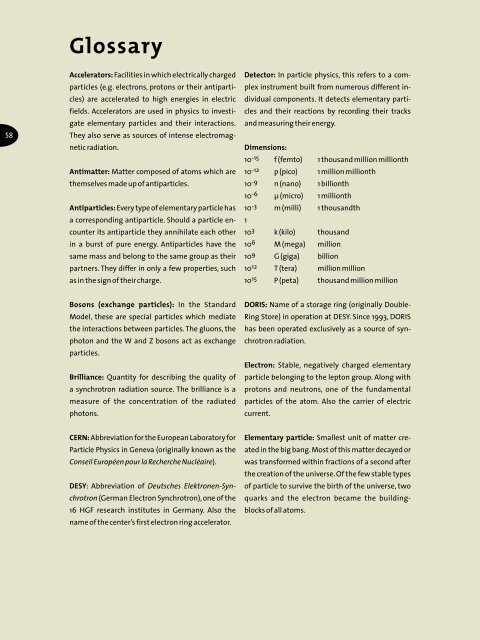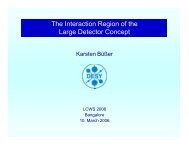TESLA Brochure - ACFA Joint Linear Collider Physics and Detector ...
TESLA Brochure - ACFA Joint Linear Collider Physics and Detector ...
TESLA Brochure - ACFA Joint Linear Collider Physics and Detector ...
You also want an ePaper? Increase the reach of your titles
YUMPU automatically turns print PDFs into web optimized ePapers that Google loves.
58<br />
Glossary<br />
Accelerators: Facilities in which electrically charged<br />
particles (e.g. electrons, protons or their antiparticles)<br />
are accelerated to high energies in electric<br />
fields. Accelerators are used in physics to investigate<br />
elementary particles <strong>and</strong> their interactions.<br />
They also serve as sources of intense electromagnetic<br />
radiation.<br />
Antimatter: Matter composed of atoms which are<br />
themselves made up of antiparticles.<br />
Antiparticles: Every type of elementary particle has<br />
a corresponding antiparticle. Should a particle encounter<br />
its antiparticle they annihilate each other<br />
in a burst of pure energy. Antiparticles have the<br />
same mass <strong>and</strong> belong to the same group as their<br />
partners. They differ in only a few properties, such<br />
as in the sign of their charge.<br />
Bosons (exchange particles): In the St<strong>and</strong>ard<br />
Model, these are special particles which mediate<br />
the interactions between particles. The gluons, the<br />
photon <strong>and</strong> the W <strong>and</strong> Z bosons act as exchange<br />
particles.<br />
Brilliance: Quantity for describing the quality of<br />
a synchrotron radiation source. The brilliance is a<br />
measure of the concentration of the radiated<br />
photons.<br />
CERN: Abbreviation for the European Laboratory for<br />
Particle <strong>Physics</strong> in Geneva (originally known as the<br />
Conseil Européen pour la Recherche Nucléaire).<br />
DESY: Abbreviation of Deutsches Elektronen-Synchrotron<br />
(German Electron Synchrotron), one of the<br />
16 HGF research institutes in Germany. Also the<br />
name of the center’s first electron ring accelerator.<br />
<strong>Detector</strong>: In particle physics, this refers to a complex<br />
instrument built from numerous different individual<br />
components. It detects elementary particles<br />
<strong>and</strong> their reactions by recording their tracks<br />
<strong>and</strong> measuring their energy.<br />
Dimensions:<br />
10-15 f (femto) 1 thous<strong>and</strong> million millionth<br />
10-12 p (pico) 1 million millionth<br />
10-9 n (nano) 1 billionth<br />
10-6 µ (micro) 1 millionth<br />
10-3 1<br />
m (milli) 1 thous<strong>and</strong>th<br />
103 k (kilo) thous<strong>and</strong><br />
106 M (mega) million<br />
109 G (giga) billion<br />
1012 T (tera) million million<br />
1015 P (peta) thous<strong>and</strong> million million<br />
DORIS: Name of a storage ring (originally Double-<br />
Ring Store) in operation at DESY. Since 1993, DORIS<br />
has been operated exclusively as a source of synchrotron<br />
radiation.<br />
Electron: Stable, negatively charged elementary<br />
particle belonging to the lepton group. Along with<br />
protons <strong>and</strong> neutrons, one of the fundamental<br />
particles of the atom. Also the carrier of electric<br />
current.<br />
Elementary particle: Smallest unit of matter created<br />
in the big bang.Most of this matter decayed or<br />
was transformed within fractions of a second after<br />
the creation of the universe.Of the few stable types<br />
of particle to survive the birth of the universe, two<br />
quarks <strong>and</strong> the electron became the buildingblocks<br />
of all atoms.




